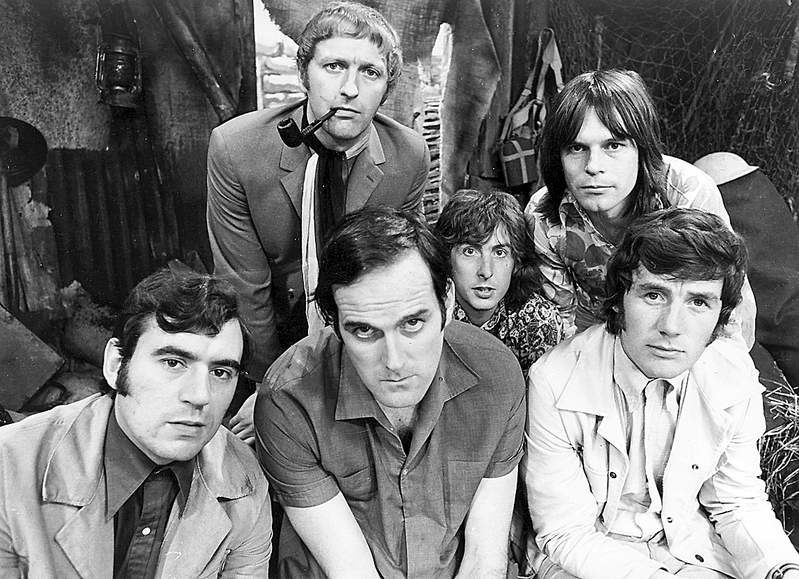Monty Python’s bright (and silly) side of life
Published 5:00 am Saturday, October 17, 2009

- The British comedy troupe Monty Python, front row from left, Terry Jones, John Cleese and Michael Palin, and back row from left, Graham Chapman, Eric Idle and Terry Gilliam, in 1969.
NEW YORK — Those who don’t know Monty Python, and don’t care, have been blessed with six hours they can spend on something other than watching IFC’s new documentary series.
Of course, all Python disciples can look forward to comedy catnip in “Monty Python: Almost the Truth (the Lawyer’s Cut),” shown from Sunday through next Friday at 9 p.m.
History. Hysterics. Silly walks. All bundled into an everything-you-wanted-to-know-or-rediscover chronicle of this legendary British comedy troupe, now marking 40 years.
The documentary’s distinctive style is clear from its first moments. After the very silly, Pythonesque title sequence, each of the five surviving Pythons is heard from in fresh on-camera interviews (plus archived interviews with its sixth member, the late Graham Chapman), musing on their respective beginnings.
No soaring introductory pronouncements of what Python accomplished and represents. That will be spelled out, step by step, in the fullness of six hours, as interviews, film and audio clips decipher how Monty Python became the most groundbreaking, transforming wellspring of comedy in the history of the world (OK, maybe a wee exaggeration).
Chapman, along with fellow Brits John Cleese, Eric Idle, Michael Palin and Terry Jones, plus Minnesota-born interloper Terry Gilliam, were children during World War II. They were shaped by radio comedy as much as television. They bridled at, and feasted on, the uptight, tradition-bound 1950s culture of their youth. They harnessed the gloriously unhinged, subversive 1960s and used it as their launching pad.
On TV (notably “Monty Python’s Flying Circus,” produced for British TV), in live performances, recordings and feature films (including the incomparable “Monty Python and the Holy Grail” and “Life of Brian”), the Pythons’ absurdist narratives and characterizations mixed raging intellect with shameless looniness. (IFC is including those two films, as well as “Monty Python Live at the Hollywood Bowl” and all four seasons of “Flying Circus” in its on-air “Python-a-Thon.”)
Though the group has been effectively disbanded for years as each Python struck out to pursue his own projects, it lives on undiminished. As recently as 2005, “Monty Python’s Spamalot,” a lavish musical based on the 1974 “Holy Grail” film, became a Broadway hit.
Meanwhile, classic Pythonesque drollery enjoys eternal life. The mere thought of “the Knights who say ‘Ni’” or “Eric the half-a-bee” or the gay lumberjack song will reduce any Python fan to a helpless silly state, never mind the passage of decades.
Why? “Almost the Truth” is marvelous at how it accounts for Monty Python in suitably comprehensive fashion. For any viewer with nothing better to do, it’s six hours gloriously spent.
Putting it together was a labor of love as well as persistence and filial pride for Bill Jones, the son of Python Terry Jones.
First order of business: enlisting the five errant Pythons.
“At first, nobody wanted to do another Python documentary, me included,” Terry Jones said pleasantly during a separate phone call. “Mike Palin got worried when they were going to pay: Nobody else had ever paid us to be interviewed for our own documentaries before. Somehow that made him suspicious.”
Among the Pythons, Terry Jones can be conveniently singled out as the explosive Mr. Creosote in “Monty Python’s Meaning of Life” and as the co-director, with Terry Gilliam, of “Holy Grail.”
“The whole idea of Python was to be totally unpredictable,” Terry Jones said when asked to summarize the troupe’s de facto mission statement. “We were trying to be undefinable.” Indefinable? Too bad. “Pythonesque” is now defined in the Oxford English Dictionary.
But en route to inventing that ineffable quality, the Pythons traveled a sometimes chaotic path. Six erudite, irreverent and willful chaps were destined to butt heads, and the documentary is particularly fascinating as it charts their fractious creative process.






